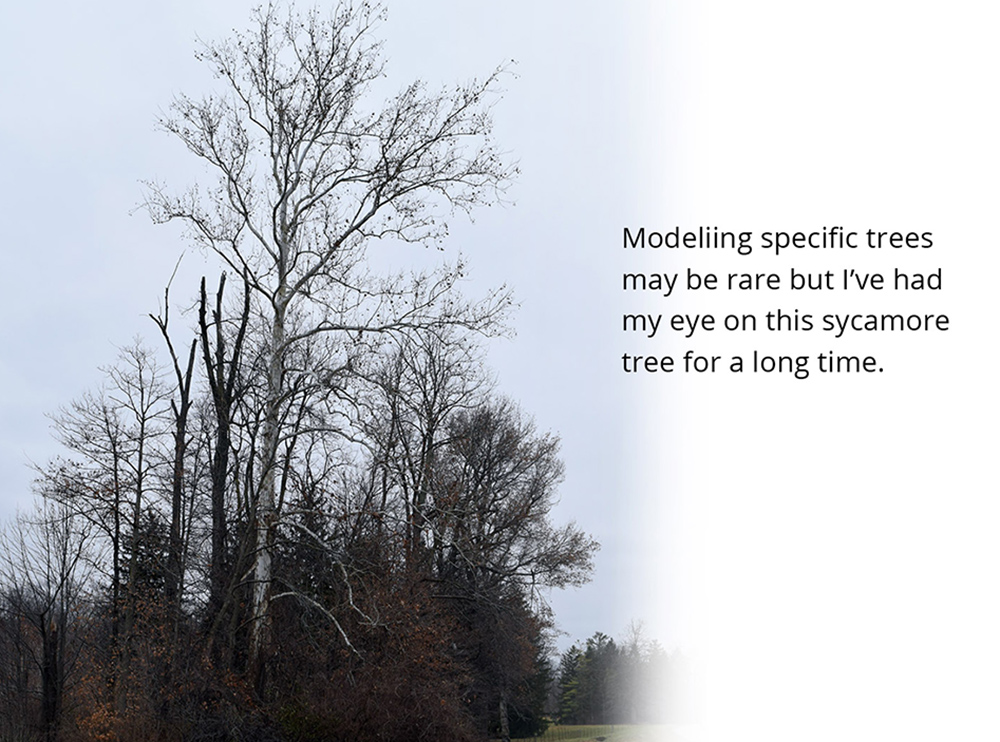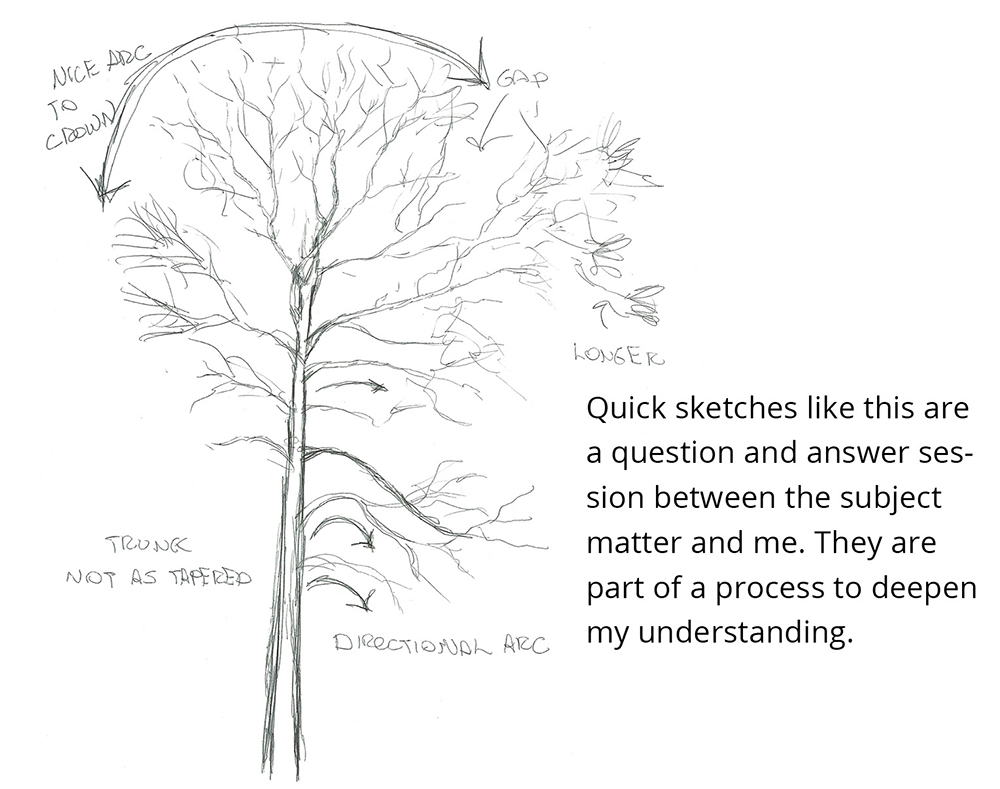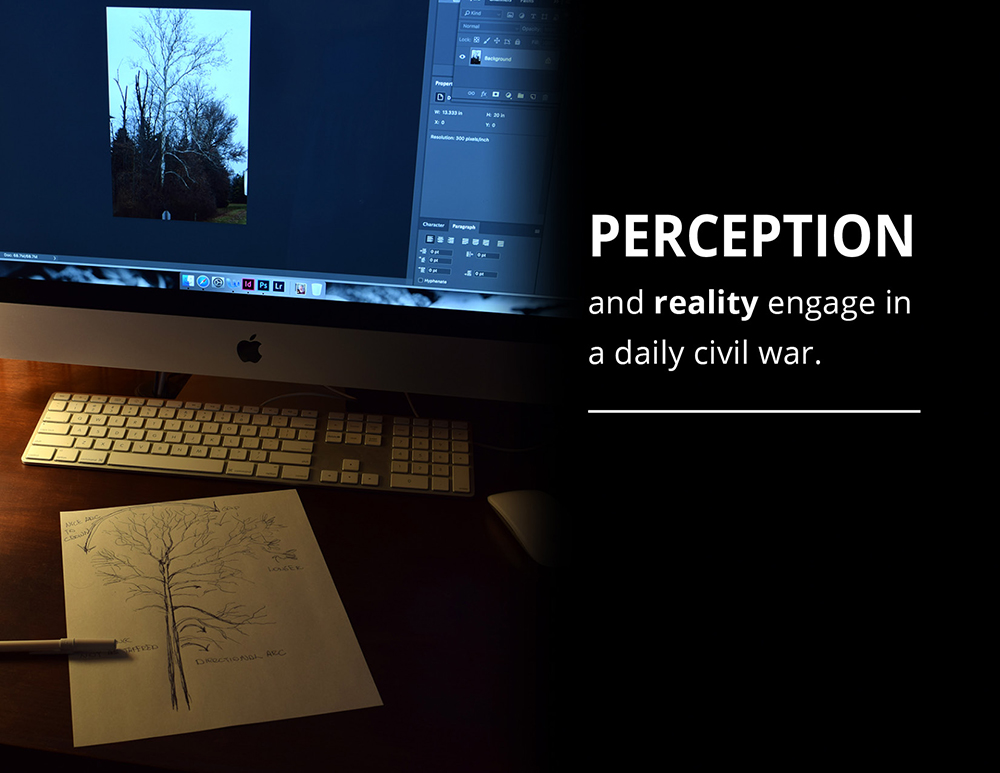Mockups Are Your Friend
The twigs and branch material you’ve seen in previous photos are simply placeholders. They are there to help me judge the placement and proportion of the trees and woodland features in relation to the ground and the trains.
Communicating A Sense Of Place
As a design element, trees have power to shape our perception and direct our gaze. Placing them haphazardly shortchanges the impact they bring. At this stage I’m looking at local woodlands and tree groupings to understand growth patterns and why they are where they are. Has development had an impact, does the terrain influence things and so on?
On the cameo I plan to use trees selectively and I want them to be recognizable models of specific trees found in this region of the country. My first model will be of this sycamore tree. It’s one I’ve had my eye on for some time.

Thanks to the shallow depth of the cameo and the forced perspective aspects I’ve incorporated, I have a delicate balance to maintain. The key aspect in this setting is the height. This is a tall spindly tree and putting it close to the backdrop may ruin other aspects of the scene, yet reducing the height too much will create a toy-like appearance when a train is present. I’ll have to experiment with different heights and determine what works.
Prepare Early Then Jump In.
Before I start twisting up wire for the trunk and branches, I’m taking my time to study this tree carefully. In addition to the photos, I’ve made sketches to learn the form and lines that give this tree its character. I’ve mentioned before that drawing, no matter how crude, is an excellent way to learn about an object. Sketches like the one shown are a question and answer session between my understanding and the subject.


How does this shape relate to that line?
What angle does that branch come off the trunk at, how long is it?
What proportion is that to that?
This process goes on and on, until I understand the basic qualities I want to capture in the model. You can do this with photos, but the hand, eye and mind coordination required to draw a subject leads to a deeper thought process.
This is where I’m at now in the modeling journey. It’s new and different. It’s challenging and scary and my first attempts are likely to be horrid and disappointing. So what? It’s okay to fail, again and again if needed. Making models of specific trees is likely not a part of the North American story of model trains but, why not? If you read this blog regularly, then you understand that modelers like us do things like this right? With the tools and materials we have available today, there’s nothing to stop anyone from taking their craft as far as they choose to. Learning is what keeps things fresh and interesting for me and maybe for you too.
Regards,
Mike
I think that making models of specific trees is not part of anyone’s story of model trains. There have been various exhortations in the British railway modelling press over the years. Somewhere I have an article by George Iliffe Stokes on modelling trees and bushes, and he provides some basic outlines of a few species, but nothing specific. This was in 1962, but he had been advocating accurate scenic modelling for many years before that. The BBC book “Model World”, which accompanied the eponymous TV series of the mid 1970s, did advise modelling specific prototypes, even trees (it stuck in my mind!) but that advice generally has been ignored.
We have seen some commercially produced model trees based on species, others described as “large deciduous”, which I suppose is some form of progress, but you raise an important point. If we are to create a truly believable model scene, then the same attention to detail and focus on the real thing applies as much to the scenic setting – especially something as large as a tree – as it does to the trains and the track.
Indeed, viewers without a strong (or any!) interest in railways will appreciate believable scenery, and the best way to create any meaningful, plausible model is to follow the prototype. And the easiest way to do that, is to model it accurately.
Hi Simon,
If you were to Google “Jukes Tree,” you would find images of a lone pine tree growing next to the tracks of the Cumbres and Toltec Railroad just south of Chama, NM. It was named for the photographer Fred Jukes, who first photographed it over a century ago. This lone tree, with its distinctive profile, defines this location on the railroad. Without this tree, it’s just another nondescript section of track. I find it curious that hobbyists brow beat each other over the smallest inaccurate detail, yet happily settle for anything green that bears even the slightest resemblance to an actual tree.
With this project, I’m not attempting a twig for twig representation. I am however, striving to capture the major branch structure and overall shape so that, if you were to compare the model to several photos of this species of tree, you could readily pick out the tree I worked from.
Mike
Mike,
Have you read Trevor Marshall’s posts about tree building? He recommends a similar approach. One comment that sticks in my mind is something along the lines of this, ” the average person (non train) can’t tell a 4-6-0 from a 4-8-4, but they sure can tell a pine tree from a maple.”
The point being that trees are easily recognized as specific types of trees. Trevor also points to a book about modeling trees by a British author. Might be worth pursuing to help you in your tree studying.
Craig
Hi Craig,
I published an extensive article from Trevor about his tree modeling in Volume 09 of my The Missing Conversation ebook series. I also have all three of Gordon Gravett’s books in my modeling library. I appreciate the heads up though.
Mike
I agree, Mike. To draw an analogy with locomotives, modelling a tree is not about getting every single rivet in the right place so much as having the right shape, proportions, texture (which does include rivets!) and final finish (paint and weathering).
A tree is about the main trunk and branches defining the shape and proportions, with the leaves providing texture and colour.
I am very interested to see your interpretation of this sycamore. I think it important that the tree clearly is recognizable as a sycamore, and getting the basic qualities that define it as an individual sycamore. It’s what you chose to imply and not include, that’ll be the fascinating part of this project to me. Looking forward to seeing what you create and how it sits in the scene.